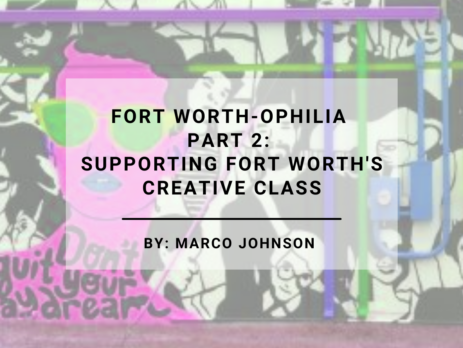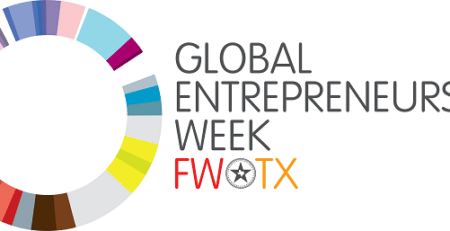In our previous post on Fort Worth-ophilia, we discussed what topophilia is, how a thriving creative class and high quality of life are positively correlated, and why a vibrant and supported creative class is the foundational ingredient for a thriving entrepreneurial community. In this post, we will identify ways we can all support our local creatives to make sure they stick around and fall in love with their city… in this case, Fort Worth.
Keep Funkytown Funky
Artists help define the identity of a community through their art and creating an authentic feeling that gives a community a unique look and feel. Our local creative class is what stands between Fort Worth remaining a creative Mecca and not becoming a bland corporate city full of big box stores and fast-food chains (except for Whataburger… we all love Whataburger). Think of the many murals around our city, the art shows and fairs like ArtsGoggle or the Main Street Arts Festival, and the many music venues that provide access to local startup bands to international headliners. Lola’s, Tulips, Billy Bob’s, and Dickies Arena all generate outsized musical contributions to our city. Fort Worth also boasts an internationally renowned cluster of museums in the Cultural District, including the Kimbell Art Museum with its collection of European paintings and antiquities and the architecturally stunning Modern Art Museum of Fort Worth. We are flush with theaters from the mainstream to the niche, and art abounds in many city parks and public spaces.



Best Practices in Supporting Creative Entrepreneurs
It is widely understood that most artists struggle financially. The term “starving artist” is all too often an accurate description of our creative citizens. Thankfully Fort Worth can learn from other communities and by listening to our own community of creatives on how best to support them. Below are some commonsense things we can do so our artists not only survive but thrive.
Affordable live+work spaces are a community asset that mixes affordable housing, community programs, and creative entrepreneurship. One of the paradoxes of artists is that they enhance their neighborhoods so much that they can’t afford to live there anymore. Cities and neighborhoods can intentionally develop affordable live+work spaces with residency programs designed to make sure artists can continue to live and work in their desired location. Artspace is a nonprofit with a national footprint dedicated to these developments.
Pay market rates to artists for their work. Many well-intentioned collectors, curators or customers offer an artist “exposure” in lieu of payment while some artists are asked to provide their services in exchange for nothing or for compensation that doesn’t match the time and effort they put into their creation. The best policy – whether you’re a curator at a big gallery or someone buying art at a street festival – is to pay market price to the seller. What is market price? Whatever the artist determines it is! Don’t haggle. Don’t offer them exposure. Don’t do anything you wouldn’t do with any other type of seller.
Recognize creatives as entrepreneurs. Artists of all stripes must know all the same business concepts that any other entrepreneur knows in order to succeed. Many creatives struggle with the business side, preferring to focus on their creative pursuits. But the reality is that the business side is no less important. Our ecosystem should organize workshops geared towards creative entrepreneurs to help them build the skills they need to thrive. Many artists don’t have a business entity and make sales under the table. To help them stay above board, experienced entrepreneurs and resource organizations should organize workshops covering entity formation, financial recordkeeping, and marketing. Even better, let’s launch a world class creative incubator or pre-accelerator program to support them as they learn and grow.
Spread the attention among local artists who work in different media. We all know and love Leon Bridges and the Toadies, but have you heard of Averi Burk, ChoKe, or DJ Perera? People tend to go with what they are familiar with, and when an artist becomes well known in their community, this translates to notoriety and hopefully lots of commissions and sales. But the entire artistic movement benefits when this attention gets spread around, particularly for artists just getting started. Our city should increase the opportunity for non-artists to collide with the creative community by developing more galleries, shows, fairs and other venues to get their creations out into the world.
Rely on art educators. The need for artists, both established and emerging, to develop business acumen is essential to sustaining Fort Worth’s entrepreneurial ecosystem, according to DJ Perera, who currently teaches these principles at Boswell High School in Eagle Mountain Saginaw ISD. Educating young artists on the economic and contractual nuances that all artists will inevitably encounter in their professional growth will protect them from being exploited as all too often happens to creatives. Furthermore, this knowledge will prepare a generation of local artists that will release maximum impact in their communities locally, nationally and globally.

To learn more about how other cities effectively support their artists and how this translates into economic success, check out our blog Nashvegas vs. Fort Worth Startup Scene to read about Nashville’s incredible transformation from Music City to Nashvegas, spurring many exciting innovations along the way.




